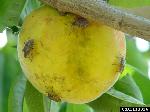COLUMBIA, Mo. – The green stink bug may emerge as a primary rather than secondary pest in the coming growing season, said Wayne Bailey, University of Missouri Extension entomologist.
Bailey said increased numbers of green stink bugs might be due to buildup of Bt proteins in corn crops, as well as no-till practices, which allow fields to go undisturbed for long periods, giving insects the opportunity to reproduce in larger numbers.
Green stink bugs cause damage in crop fields, orchards, vegetable and flower gardens, and woodlands. The pod-feeding bugs use their piercing mouthparts to draw juices from plants from May until frost. The bug can cause grains of corn to shrivel, but the most damage is done to soybean crops. Generally, damaged plants will be on the edge of a field.
The bright green bug is about a half-inch long and has an elongated, shield-shaped body. Adults and nymphs have large stink glands on the underside of the thorax, which they use to discharge large amounts of foul-smelling liquid. Groups of bugs will simultaneously discharge the smelly substance when even one insect is disturbed.
Green stink bugs have been found in coastal areas of the eastern United States and recently some have made their way to St. Louis.
Another smelly pest, the exotic brown marmorated stink bug, is appearing in in Missouri for the first time, though in low numbers. Dead specimens were found in Columbia in a stored travel trailer from the East Coast.
Native to China, the brown marmorated stink bug appeared in the U.S. in 1998 in Allentown, Pa., and is now found in 33 states. It grows to a length of about three-fourths of an inch. The shield-shaped body has alternating black and white triangles on the back edge of its wings. White bands appear on the long antennae and the hind legs. The distinguishing feature is a white underbelly.
All stink bugs are difficult to control because they overwinter in homes. Bailey says that if stink bugs discharge their smell indoors, residents may find it necessary to leave their home for several hours.
The best way to rid a house of the bugs is to vacuum them and release them outside, although the smell may remain with the vacuum cleaner. Squashing the bugs is not a good idea because that will release their odor.
More pesticides are becoming available for use against stink bugs, Bailey said.
For more information, see the MU Extension publication “Soybean Pest Management: Stink Bugs” (G7151), available for free download at extension.missouri.edu/g7151.
Read more http://extension.missouri.edu/news/DisplayStory.aspx?N=1680






